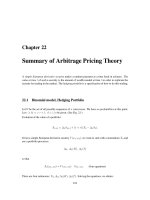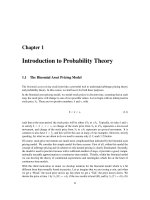bayesian decision theory
Bạn đang xem bản rút gọn của tài liệu. Xem và tải ngay bản đầy đủ của tài liệu tại đây (266.14 KB, 40 trang )
Bayesian Decision Theory
Robert Jacobs
Department of Brain & Cognitive Sciences
University of Rochester
Types of Decisions
• Many different types of decision-making situations
– Single decisions under uncertainty
• Ex: Is a visual object an apple or an orange?
– Sequences of decisions under uncertainty
• Ex: What sequence of moves will allow me to win a chess game?
– Choice between incommensurable commodities
• Ex: Should we buy guns or butter?
– Choices involving the relative values a person assigns to
payoffs at different moments in time
• Ex: Would I rather have $100 today or $105 tomorrow?
– Decision making in social or group environments
• Ex: How do my decisions depend on the actions of others?
Normative Versus Descriptive
Decision Theory
• Normative: concerned with identifying the best decision to
make assuming an ideal decision maker who is:
– fully informed
– able to compute with perfect accuracy
– fully rational
• Descriptive: concerned with describing what people
actually do
Decision Making Under Uncertainty
• Pascal’s Wager:
• Expected payoff of believing in God is greater than the
expected payoff of not believing in God
– Believe in God!!!
0- ∞ (hell)Live as if God does
not exist
0∞ (heaven)Live as if God
exists
God does not existGod exists
Outline
• Signal Detection Theory
• Bayesian Decision Theory
• Dynamic Decision Making
– Sequences of decisions
Signal Detection Theory (SDT)
• SDT used to analyze experimental data where the task is to
categorize ambiguous stimuli which are either:
– Generated by a known process (signal)
– Obtained by chance (noise)
• Example: Radar operator must decide if radar screen
indicates presence of enemy bomber or indicates noise
Signal Detection Theory
• Example: Face memory experiment
– Stage 1: Subject memorizes faces in study set
– Stage 2: Subject decides if each face in test set was seen
during Stage 1 or is novel
• Decide based on internal feeling (sense of familiarity)
– Strong sense: decide face was seen earlier (signal)
– Weak sense: decide face was not seen earlier (noise)
Correct RejectionFalse AlarmSignal Absent
MissHitSignal Present
Decide NoDecide Yes
• Four types of responses are not independent
Ex: When signal is present, proportion of hits and proportion
of misses sum to 1
Signal Detection Theory
Signal Detection Theory
• Explain responses via two parameters:
– Sensitivity: measures difficulty of task
• when task is easy, signal and noise are well separated
• when task is hard, signal and noise overlap
– Bias: measures strategy of subject
• subject who always decides “yes” will never have any misses
• subject who always decides “no” will never have any hits
• Historically, SDT is important because previous methods
did not adequately distinguish between the real sensitivity
of subjects and their (potential) response biases.
SDT Model Assumptions
• Subject’s responses depend on intensity of a hidden
variable (e.g., familiarity of a face)
• Subject responds “yes” when intensity exceeds threshold
• Hidden variable values for noise have a Normal
distribution
• Signal is added to the noise
– Hidden variable values for signal have a Normal
distribution with the same variance as the noise
distribution
SDT Model
SDT Model
• Measure of sensitivity (independent of biases):
• Given assumptions, its possible to estimate d
’
subject
from
number of hits and false alarms
• Subject’s efficiency:
σ
µ
µ
Ns
optimal
d
−
=
'
'
'
Efficiency
optimal
subject
d
d
=
Bayesian Decision Theory
• Statistical approach quantifying tradeoffs between various
decisions using probabilities and costs that accompany
such decisions
• Example: Patient has trouble breathing
– Decision: Asthma versus Lung cancer
– Decide lung cancer when person has asthma
• Cost: moderately high (e.g., order unnecessary tests, scare
patient)
– Decide asthma when person has lung cancer
• Cost: very high (e.g., lose opportunity to treat cancer at early
stage, death)
Example
• Fruits enter warehouse on a conveyer belt. Decide apple
versus orange.
• w = type of fruit
– w
1
= apple
– w
2
= orange
• P(w
1
) = prior probability that next fruit is an apple
• P(w
2
) = prior probability that next fruit is an orange
Decision Rules
• Progression of decision rules:
– (1) Decide based on prior probabilities
– (2) Decide based on posterior probabilities
– (3) Decide based on risk
(1) Decide Using Priors
• Based solely on prior information:
• What is probability of error?
otherwise
wPwP
w
w
Decide
)()(
21
2
1
>
)](),(min[)(
21
wPwPerrorP
=
(2) Decide Using Posteriors
• Collect data about individual item of fruit
– Use lightness of fruit, denoted x, to improve decision
making
• Use Bayes rule to combine data and prior information
• Class-Conditional probabilities
– p(x | w
1
) = probability of lightness given apple
– p(x | w
2
) = probability of lightness given orange
−10 −5 0 5 10
0
0.02
0.04
0.06
0.08
0.1
0.12
0.14
0.16
0.18
0.2
Lightness
Class−Conditional Probability
Orange
Apple
Bayes’ Rule
• Posterior probabilities:
)(
)()|(
)|(
xp
wpwxp
xwP
ii
i
=
Likelihood
Prior
Bayes Decision Rule
otherwise
xwPxwP
w
w
Decide
)|()|(
21
2
1
>
• Probability of error:
)]|(),|(min[)|(
21
xwPxwPxerrorP
=
−10 −5 0 5 10
0
0.1
0.2
0.3
0.4
0.5
0.6
0.7
0.8
0.9
1
Lightness
Posterior Probability
Threshold
Orange
Apple
Assume equal prior probabilities:
−10 −5 0 5 10
0
0.1
0.2
0.3
0.4
0.5
0.6
0.7
0.8
0.9
1
Lightness
Posterior Probability
Prior probabilities: P(orange) > P(apple)
(3) Decide Using Risk
• L(a
i
| w
j
) = loss incurred when take action a
i
and the true state
of the world is w
j
• Expected loss (or conditional risk) when taking action a
i
:
)|()|()|( xwPwaLxaR
jj
j
ii
∑
=
Loss function Posterior
Minimum Risk Classification
• a(x) = decision rule for choosing an action when x is
observed
• Bayes decision rule: minimize risk by selecting the action a
i
for which R(a
i
| x) is minimum
Loss Functions for Classification
• Zero-One Loss
– If decision correct, loss is zero
– If decision incorrect, loss is one
• What if we use an asymmetric loss function?
– L(apple | orange) > L(orange | apple)









